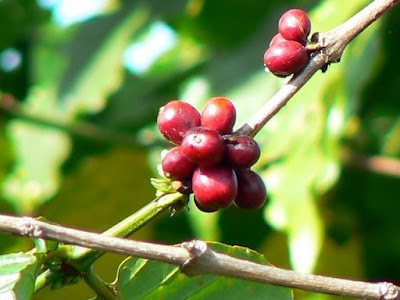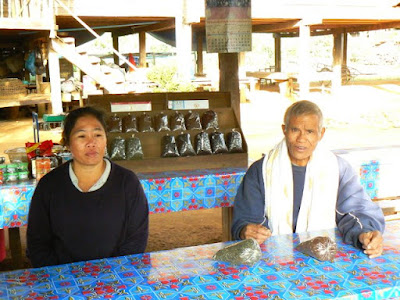
Up on the Bolaven Plateau I met a guy driving one of those Honda 200cc Enduros. He told me that he rented it from the Lankham so that's directly where I headed on return to Pakse.
Usually I speak Lao to people working in hotels, my 200 word vocabulary is easier than the usual 20 words of English spoken at the reception desk. At the Lankham I switched to English after the first sentence. The owner's son and his wife manage the hotel and both are very fluent English speakers.

Owner and grandson
The owners of the Lankham are an ethnic Vietnamese family. I say ethnic because they are 100% Lao by nationality. They all speak Lao when talking amongst themselves, even grandma. The family is educated, one son received advanced degrees in China, the other in America, both by scholarship.
The hotel is a smoothly functioning business as it needs to be with so many working there. The lobby is always attended and has many people checking in and out, getting left luggage, renting motorcycles, using the net, or booking tickets, all the time. The room I rented was cheaper than the competition, and though small, was clean, with AC, TV, fridge, and it all worked. A heck of a lot of Thai and Chinese stay there, good value. I think the rooms on the second floor are better and higher priced. I don't remember what I paid, not too much. There are two halls with rooms both sides and 3 upper floors, maybe 60 rooms or more. Out front is an espresso cart with a blender for smoothies too.

Ashtray Lankham
I was forthcoming about what I intended to use the bike for, and daughter in law suggested I didn't need a large bike but one of the made in Thailand Suzuki 125s might be plenty of power for the slow roads. Not as expensive as the dirt bike, but a lot more solid than the Kaolaos. Good call. Unstated, but in my mind, parts and repairs are a lot easier too. Try getting a large unusual bike worked on in a small village, might not have the right sized tires. The bike I was shown was shiny new looking, I checked the lights and brakes then hopped on to take it around the block, odometer read 450km, the thing was brand spanking new. I left it at the attached mechanics shop around back for the night and they changed the oil and adjusted up the brakes a smidgen.

Street in front of Lankham
But good rooms, great service, informed conversation, and reputable rental is not what really impressed me, it was the foe. In Vietnamese spelled "pho" and in all languages pronounced like the fur of the dog that bit you but without the R. Maybe more resembling the Fur of Fur Elise the famous bagatelle by Beethoven. Like Fur Elise good foe is understated excellence when done right.
Not the usual piano and not understated excellence but I liked it, in the style of Jimi Hendrix.
I'm not sure how foe is made in Vietnam where it comes from but in Laos the broth is light but extremely flavorful. Very little color to the soup but packed full of tastes that combine and compliment each other and are hard to pin down. At the Lankham in the early morning I saw them bringing the ribs of two whole cows fresh from the butcher to make the broth. Over twenty people are employed in the preparation, cooking, and serving of the foe. Everyone has their special job from preparing the ribs by trimming off the bits they don't want to cutting vegetables, setting and clearing tables and so on.
What's in the soup besides cow bones? I don't know. Often foe tastes of cinnamon or anise, and probably they were in the water at the Lankham, I don't know, but in no way did I taste them. Maybe they don't use them, I don't know, same with salt and bang nua. All of the flavors are subtle enough that they can't be pinned down. When the broth pours it shines, clear it is, thin it's not.

Second best thing in the world, foe at the Lankham
I only saw one person cooking the noodles, I have to assume it was the woman in charge of the business. The foe restaurant is operated by the sister of the owner. Of course the thin sen foe (foe noodles) are just barely cooked enough. Thin sliced beef and green onions minced are added so that they are barely cooked and they cool the soup down enough so that when it arrives it is hot, but not scalding, you can eat it right away.
On the side and complimentary is a large glass of unsweetened weak iced tea in a bottomless glass. Also you get a bowl of just barely cooked, still slightly stiff, boiled cabbage chunks and green beans without any added flavoring. More of the same uncooked in a bowl in front of you, and a tin with a lid and chunks of lime to squeeze. Lettuce leaves, cilantro, basil, sprouts, hot peppers, everything you could use with foe.
I squeeze a couple slices of lime and dig in, after half a bowl I devour all the boiled cabbage and half the beans. The boiled veggies are great, clean the pallet, tasty, a break from the constant chomping on lettuce, mint, and cilantro that usually accompanies me eating of foe.
The meal isn't cheap. Maybe twenty thousand kip or so. Between eight and nine there's a big office crowd from all the government offices and banks. Tables are big, they can seat eight or ten people, and seating is communal, just pull up a chair. Mid morning us tourists and a few business people wanting to talk away from the office. What better way to clinch the deal than over a great bowl of foe. Lunch crowd is over and done with by 1:30 and by mid-afternoon all the huge pots are scrubbed and dishes washed and stored awaiting the next dawn.
Haven't eaten foe at the Lankham Hotel? Well you haven't really been to Pakse yet.


























